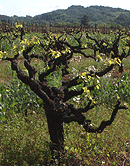|
Wineries
Wines
More Info. |

Serving
Wine Correctly serving wine is
simple and will allow for the maximum enjoyment of
the wine for you and your guests. Temperature The most important factor in
serving a wine is the temperature of the wine.
Generally, white wines are served at cooler
temperatures and red wines are served from cool to
room temperature. Sparkling wines are served the
coolest of all wines. The table below lists the
optimal temperatures of serving most California
wines. Wine that is served too cold will have a
decreased bouquet and wine that is too warm will
taste dull and harsh. Hint: The quickest way
to chill a bottle of wine is to immerse the bottle
in a bucket filled with equal amounts of ice and
water. Opening
the Bottle Most wines are sealed with a
natural cork although many bottlers are now
choosing an artificial cork due to some advantages
that they offer. If the bottle has a foil capsule
covering the lip, a knife or foil cutter should be
used to cut the foil about 1/4 inch below the lip
of the bottle and then the top portion removed. If
the bottle has a wax seal at the top of the cork in
lieu of a foil capsule (now frequently found on
white wines), the seal does not need to be removed.
A corkscrew, cork puller or air injection device
must be used to remove the cork. The simplest
device is a corkscrew with some mechanism for
leverage. A two-pronged cork puller may take some
practice, as the prongs are inserted between the
cork and bottle and then an upward twisting motion
is used to remove the cork. Care must be taken to
not damage the cork or to push the cork into the
bottle during the insertion stage. Some devices
consist of a hypodermic needle connected to an air
pump in which the needle is pushed through the cork
and air pressure is used to raise the cork. After
the cork is removed the lip of the bottle should be
wiped to remove any residue or cork
pieces. Sparkling wines usually have
a natural or artificial cork which is held tight
against the bottle by a wire cage. After removing
the outer foil, the cage may be removed by twisting
the looped tab at the bottom of the cage. Sparkling
wines are under pressure so care must be taken so
that the cork does not pop out and hit someone.
Holding the bottle at a 45 degree angle with one
hand holding the neck of the bottle (with the thumb
over the top of the cork), gently rotate the bottle
with the other hand. As the cork loostens, slowly
guide the cork out of the bottle. You should hear a
muted "poof" sound. Hint: before rotating
the bottle, hold your hand around the neck of the
bottle for about ten seconds to warm the seal
between the bottle and the cork. The cork should
remove a little easier. Pouring and
Serving Clear wine glasses should
always be used so that the color and clarity of the
wine are easily seen. Most wine glasses curve
inward toward the top so that the aroma and bouquet
of the wine is enhanced and gentle swirling (to
increase the surface area of the wine) is possible.
The wine glass should be filled no more than
half-way to allow for swirling. Wine glasses used for white
wine are usually tall and oval shaped while glasses
used for red wines are usually rounder. Glasses
used for sparkling wines, called flutes, are
usually slender and narrow which decreases the area
for bubbles to escape. Holding the flute at an
angle while slowly pouring the sparkling wine will
decrease the amount of "foam" that appears in the
glass. Many wine experts prefer to
decant red wines before serving to allow them to
"breathe" in order to enhance their bouquet. This
process is also used to separate the sediment that
is sometimes found in older (aged) red
wines. Storing Open
Wines A wine's flavor will rapidly
degrade with prolonged contact with air, therefore
the storage of wine after it is opened must be
accomplished by limiting air contact. The most
effective way is to transfer the wine to a smaller
bottle. Most premium wine bottles contain 750 ml of
wine whereas many dessert wines are sold in 375 ml
bottles. Transferring a half-bottle of open wine to
a clean 375 ml bottle (filling as much as possible)
is the preferred method. Vacuum wine savers are
available that consist of a vacuum pump and bottle
cap with a valve. Placing the cap on the bottle and
removing the air from the bottle will minimize air
contact. Other devices are available that will pump
gas from a cartridge into the bottle and force the
air from the bottle. Proper
Temperatures for Serving Wines The temperature at which wine
is served can greatly affect the taste of the wine,
due to the way in which esters react to
temperature. Wine is generally aged at
approximately 55 degrees Farenheit and many will
agree that this is the proper temperature to drink
wine, both white and red. In general terms, I would
agree to this. White wines stored in a refrigerator
are too cold and should sit at room temperature
before being consumed and red wines are best at
slightly cooler than room temperature. Below are
some guggested serving temperatures, although your
tastes may vary. Degrees
Farenheit Cabernet
Sauvignon 62 to
67 Pinot Noir 58 to
63 Zinfandel
(Light) 57 to
62 Tawny Port
(Older) 55 to
60 Chardonnay
(Premium) 50 to
55 Chardonnay
(Average) 45 to
50 Chenin Blanc 43 to
48 Sparkling WInes
(Better) 42 to
47 Sparkling Wines
(Inexpensive) 40 to
44 Next in this
series: Tasting
Wines
|
